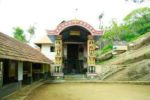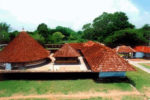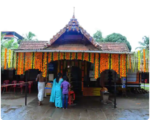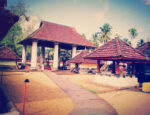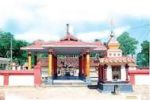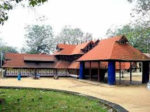Temple Name:
Alternate Spellings:
Dakshina Kailasam
Listing Category
Significance:
Stamping on fried pappads is done for the healing of diseases on feet
Location:
Mullurkara
Address:
Irunilamkode Temple, Mullurkara P.O.,Thrissur, Kerala
680583
680583
District:
Thrissur
Google Tag:
10°42’44″N 76°15’27″E
Phone No:
91-9947-472-287 | 04884 273483 | 9847 558782
Website:
Email id:
mail@irunilamkodetemple.com
Temple Timings:
5 am to 12 noon and 5 pm to 7 pm
Temple Type:
Other
If Other is Chosen, pls specify:
Archaeological survey of India
Presiding deity:
Siva
Sub Deities:
Vishnu, Devi Parvati, Murugan, Ganapathi, Ayyappan
Offerings:
The offering (Vazhipads) conducted here are very strange and rare. More than 30 items of vazhipads are held here. PAPPADAM CHAVITTAL (Stamping on fried pappadams) is one among the popular vazhipad. This is done for the healing of diseases on the feet. CHOOL VAZHIPAD is another popular one (brooming over the head and neck). This is done for the abnormal falling of hairs found in ladies.
Festivals:
Skanda Shashti, Mahashivarathri The main festival celebrated here is ‘ SKANTHA SHASHTY’. It falls in October or November every year. A number of ‘KAVADI’s in sets come to the temple yard with singing, dancing and beating on drums with a competitive spirit. The participants are given a small amount as a token to their efforts.
“THAIPOOYAM” is another festival observed here.
ANNADANAM (Serving of free food) is the main activity of temple. Near about 300-400 devotees are given free food daily. A decorated chariot installed with an idol of Sri Subramaniyaswamy mounted on a mini lorry goes round the whole panchayath, house to house. This function is called ‘OORUCHUTTAL’. The concept is that the lord visits his devotees houses and bless them.
“THAIPOOYAM” is another festival observed here.
ANNADANAM (Serving of free food) is the main activity of temple. Near about 300-400 devotees are given free food daily. A decorated chariot installed with an idol of Sri Subramaniyaswamy mounted on a mini lorry goes round the whole panchayath, house to house. This function is called ‘OORUCHUTTAL’. The concept is that the lord visits his devotees houses and bless them.
History:
For, thousands of years, this temple was unknown and unseen to the public. About 300 years ago some villagers located it accidentally. One day, when it was raining a lady worker went inside the cave. There she started sharpening her sickle. Meanwhile she found a red liquid on her finger tip and feared, it was cut, she checked it. But she could find no mark of any injury.With anxiety and curiosity she observed the rock part where she sharpened her sickle. To her great surprise, she saw the same liquid slowly coming out drop by drop. Her anxiety grew up. She ran to the villagers and told them about the incident with a choking voice and sobs. They immediately rushed to the spot with thrilling hearts. They found the rock site, watched keenly and carefully.They saw the same liquid coming out.They started removing the bushes grass and creepers slowly and carefully. They convinced the presence of some super human power there. They were stunned when they saw the complete shape of the deity. Some of them went into ecstasy. With folded hands they paid their respects and ‘Pranams’ to the Lord.
This temple is renowned for religious harmony. Regardless of caste or creed persons could enter the temple and perform the worship themselves. They were free to touch the lord’s feet. Even before Kerala temple entry promulgation, perhaps, Irunilamkode temple stood first in the history of religious harmony. A number of devotees, not only from Kerala but from Tamilnadu and Karnataka also visited the temple. MUNIYARA (DHAKSHINAKAILASAM) is a small man-made cave (Muni-hermit;ara-cave). It is at the top of the hill-lock. There were other similar types of caves here. They have been demolished by natural erosive powers. The only one cave now retaining is under the protection of the temple authorities. An idol of ‘Sivalinga is installed and worshiped inside this cave. Devotees visiting the temple are also expected to visit this cave also to fulfill the purpose of their visit.
The histories of these caves are marvellous and interesting. Long ago ardent devotees from various parts of the country highly intoxicated with God fervor came here. They stayed here and practiced rigorous spiritual sadhanas. They built these caves with the help of villagers to protect themselves from hot sun, cold and wild animals. The villagers fed them and met other necessities. So they could merge in their sadhanas full time deeply. As a result some of them got realization or vision of God. The rest of their life stayed here giving spiritual advises those who approached them.
In course of time these seekers attention was diverted to some other centres. Subsequently these caves and rock remained isolated and uncared.
This temple is renowned for religious harmony. Regardless of caste or creed persons could enter the temple and perform the worship themselves. They were free to touch the lord’s feet. Even before Kerala temple entry promulgation, perhaps, Irunilamkode temple stood first in the history of religious harmony. A number of devotees, not only from Kerala but from Tamilnadu and Karnataka also visited the temple. MUNIYARA (DHAKSHINAKAILASAM) is a small man-made cave (Muni-hermit;ara-cave). It is at the top of the hill-lock. There were other similar types of caves here. They have been demolished by natural erosive powers. The only one cave now retaining is under the protection of the temple authorities. An idol of ‘Sivalinga is installed and worshiped inside this cave. Devotees visiting the temple are also expected to visit this cave also to fulfill the purpose of their visit.
The histories of these caves are marvellous and interesting. Long ago ardent devotees from various parts of the country highly intoxicated with God fervor came here. They stayed here and practiced rigorous spiritual sadhanas. They built these caves with the help of villagers to protect themselves from hot sun, cold and wild animals. The villagers fed them and met other necessities. So they could merge in their sadhanas full time deeply. As a result some of them got realization or vision of God. The rest of their life stayed here giving spiritual advises those who approached them.
In course of time these seekers attention was diverted to some other centres. Subsequently these caves and rock remained isolated and uncared.
Updated on:
23/11/2018 by Smitha
Temple Name:
Listing Category
Significance:
Devotees visit this temple to seek fulfillment of the following:-
Auspicious beginnings of work | Removal of obstacles | Renewal of energy Success | Wisdom Agricultural productivity
Auspicious beginnings of work | Removal of obstacles | Renewal of energy Success | Wisdom Agricultural productivity
Location:
Kunnamkulam
Address:
Kakkad Mahaganapathi Temple,
Kunnamkulam, District,
Kerala.
680503
Kunnamkulam, District,
Kerala.
680503
District:
Thrissur
Google Tag:
10.6580° N, 76.0645° E
Phone No:
04885 212021 +91 9847570504 +91 9847344710 +91 9495041022+91 8547474848
Email id:
kakkadganapathy@gmail.com
Temple Timings:
5:00am to 10:30am 5:00pm to 8:00pm
Temple Type:
Dewaswom
Presiding deity:
Lord Mahaganapathy and Lord Shiva
Sub Deities:
Navagrahas, Nagas, Durga, Bhadrakali
Offerings:
Mahaganapathi Homam to remove all obstacles;
Mangalya Pooja to clear away all the obstacles in marriage,
Santhana Pooja for Children and for the Fulfilment of desires.
Elephant horn in gold is offered in place of ivory.
Other important offerings are Niramala Vettakaran Pattu, Udayasthamana Pooja, Koottappam etc.
Reading of Ramayana Navahayanjam, Bhagavathasapthaham, Ganesha Puranam, Sivapuranam etc. are also performed .
Mangalya Pooja to clear away all the obstacles in marriage,
Santhana Pooja for Children and for the Fulfilment of desires.
Elephant horn in gold is offered in place of ivory.
Other important offerings are Niramala Vettakaran Pattu, Udayasthamana Pooja, Koottappam etc.
Reading of Ramayana Navahayanjam, Bhagavathasapthaham, Ganesha Puranam, Sivapuranam etc. are also performed .
Festivals:
Vinayaka Chathurthy of Chingamasam is a grand festival.
Vettakaran pattu: On first saturday of January, breaking of 12008 coconuts by the Komaram is done.
An 8 day Festival is celebrated every year with Kodiyettam on Thiruvathira star in Malayalam month of Meenam and concluding with the Pallivetta 7th day Arattu on the 8th day. Chakyarkoothu Ottanthullal, Dance, Bhajans etc. are performed during these 8 day’s of festival.
On next sunday after Arattu the residents of Kakkad celebrating Deshapooram.
The Prathishta Day (Prathishta Dinam) is celebrating on the Aswathi Nakshathrame day of the Malayalam month Kumbham.
Vettakaran pattu: On first saturday of January, breaking of 12008 coconuts by the Komaram is done.
An 8 day Festival is celebrated every year with Kodiyettam on Thiruvathira star in Malayalam month of Meenam and concluding with the Pallivetta 7th day Arattu on the 8th day. Chakyarkoothu Ottanthullal, Dance, Bhajans etc. are performed during these 8 day’s of festival.
On next sunday after Arattu the residents of Kakkad celebrating Deshapooram.
The Prathishta Day (Prathishta Dinam) is celebrating on the Aswathi Nakshathrame day of the Malayalam month Kumbham.
History:
In 1921, Kakkad Karanawar, Manakulam Kunjunni Raja and his nephew Mukunda Raja and Mahakavi Vallathol jointly formed Kalamandalam and began the performance of Kathakali in this temple. Thus the temple became famous in Kerala as well as outside. Prasadaoottu is conducted on Prathishta day, Vinayaka Chathurthi, Vettaikaran Pattu and on every first friday of each malayalam month food is distributed to the devotees after Nivedyam.
Updated on:
05/07/2019 by Komal
Temple Name:
Alternate Spellings:
Kerala Mookambika Shetram | Mulavallikav Saraswathi Temple
Listing Category
Significance:
Mulavallikav devi is believed to be “Sarvabeeshtapradhayini” (one who grants all wishes). Pilgrims who pray with sincerety and with utmost devotion will be blessed with health, wealth and all.
Location:
Koratty
Address:
Kerala Mookambika Sree Mulavallikav Devi Temple, Near NUP School, Behind NSS Karayogam Hall,West Koratty, P.O.Mambra,Trichur, Kerala
District:
Thrissur
Google Tag:
10°14’51″N 76°21’4″E
Phone No:
9947420782 9895968168 9496531750
Email id:
NA
Temple Timings:
Sunday 6am – 9am
Temple Type:
Other
If Other is Chosen, pls specify:
Kshethra Samrakshana Samithi
Presiding deity:
Bhagavathy Saraswathy Devi
Sub Deities:
NA
History:
Kerala Mookambika Sree Mulavallikav Devi Temple is considered as one of the most important devi temples among the 108 durga temples (77th) believed to have been consecrated by the legendary warrior Parasurama who is also credited with creating the state of kerala.
The Mulavallikav Devi (soyambhu) Temple known as Mulavallikav Saraswathi Temple, Koratty Devi Temple and also known as “Kerala Mookambika Shetram” (Kerala mookambika Temple) because of whatever mulavallikav devi pooja vidhi all are same in Kollur Mookambika Devi Temple.
According to the legends, lord parasurama created the land between gokarna and kanyakumari. Lord parasurama the sixth incarnation of lord vishnu was the son of sage jamadagni and renuka. As a mark of repentance for shatriya nigraha sin, parasurama meditated at gokarna and invoked lord varuna (the lord of the oceans). Parasurama asked him for a boon to absolve himself of the sins he had committed, he wanted to donate some land to the brahmins. There was no land available because he already donated the whole land he obtained by the 21 round shatriya nigraha to sage kashyapa. Lord varuna told parasurama that he would give him as much land as he wished. He told him to fling his parasu (axe) from where he stood at gokarna. The land from gokarna till the point where the axe landed would be given to him was the boon that lord varuna promised him. The throw of the `axe’ from gokarna to kanyakumari created kerala. Parasurama donated this land to the brahmins and settled brahmins there in 64 gramams or villages. 32 out of the 64 gramams are in the Tulu speaking region (in between gokarnam and perumpuzha) and the remaining 32 grammams are in the malayalam speaking region(in between perumpuzha and kanyakumari) in kerala. After the creation of these gramams, parasurama had consecrated 108 shiva temples and 108 durga temples for the well-being and prosperity of the people in kerala . The names of these temples were given in the famous 108 Durgalaya Nama Stothra and 108 shivalaya nama stothra.
The Mulavallikav Devi (soyambhu) Temple known as Mulavallikav Saraswathi Temple, Koratty Devi Temple and also known as “Kerala Mookambika Shetram” (Kerala mookambika Temple) because of whatever mulavallikav devi pooja vidhi all are same in Kollur Mookambika Devi Temple.
According to the legends, lord parasurama created the land between gokarna and kanyakumari. Lord parasurama the sixth incarnation of lord vishnu was the son of sage jamadagni and renuka. As a mark of repentance for shatriya nigraha sin, parasurama meditated at gokarna and invoked lord varuna (the lord of the oceans). Parasurama asked him for a boon to absolve himself of the sins he had committed, he wanted to donate some land to the brahmins. There was no land available because he already donated the whole land he obtained by the 21 round shatriya nigraha to sage kashyapa. Lord varuna told parasurama that he would give him as much land as he wished. He told him to fling his parasu (axe) from where he stood at gokarna. The land from gokarna till the point where the axe landed would be given to him was the boon that lord varuna promised him. The throw of the `axe’ from gokarna to kanyakumari created kerala. Parasurama donated this land to the brahmins and settled brahmins there in 64 gramams or villages. 32 out of the 64 gramams are in the Tulu speaking region (in between gokarnam and perumpuzha) and the remaining 32 grammams are in the malayalam speaking region(in between perumpuzha and kanyakumari) in kerala. After the creation of these gramams, parasurama had consecrated 108 shiva temples and 108 durga temples for the well-being and prosperity of the people in kerala . The names of these temples were given in the famous 108 Durgalaya Nama Stothra and 108 shivalaya nama stothra.
Updated on:
05/07/2019 by Komal
Temple Name:
Alternate Spellings:
Neithalakkavu Temple
Listing Category
Location:
Kuttur
Address:
Sri Naithalakkavu temple
(Cochin Devaswom Board)
Kuttur -Thrissur
(Cochin Devaswom Board)
Kuttur -Thrissur
District:
Thrissur
Phone No:
+91 487 2382220 +91 9446037681
Email id:
naithalakkavutemple@gmail.com
Temple Timings:
5am – 10am; 5:30pm – 7:30pm
Temple Type:
Dewaswom
Presiding deity:
Lord Siva and Naithalakkavu Amma
Sub Deities:
Sri Durga, Shastra, Ganapathi, Anthimahakalan, Rashasu & Dampathu Rashasu
Updated on:
05/07/2019 by Komal
Temple Name:
Alternate Spellings:
Nelluvai Sree Dhanwanthari Temple
Listing Category
Significance:
It is believed that all type of diseases can be cured by worshipping Lord Dhanwanthari. Large number of devotees visit this temple for this purpose.
Location:
Nelluwaya
Address:
Nelluvai Pattambi Road, Nelluwaya, Kerala
680584
680584
District:
Thrissur
Google Tag:
NA
Phone No:
094476 17612, 04885-264269
Email id:
admin@nelluvaidhanwantharitemple.org
Temple Timings:
5am – 10:30am | 5pm – 8pm
Temple Type:
Dewaswom
Presiding deity:
Lord Dhanwanthari – another manifestation of Lord Maha Vishnu
Sub Deities:
NA
Offerings:
Udayasthamana Pooja
Dhanwanthari Homam
Dhanwanthari Pooja
Dhanwanthari Archana
Mukkudi Nivedyam
Attayum Kuzhambum
Niramaala Chuttuvilakku
Thiruvona Oottu
Bhajanam
Dhanwanthari Homam
Dhanwanthari Pooja
Dhanwanthari Archana
Mukkudi Nivedyam
Attayum Kuzhambum
Niramaala Chuttuvilakku
Thiruvona Oottu
Bhajanam
Festivals:
VAIKUNDA EKADHASI / Swargavaathil Ekadashi
The Swargavaathil Ekadashi in Veluththa Paksham in Malayalam month Dhanu is very important. The Shuddhi Karmas starts from Ashtami. There will be Navakam, Panchagavyam and Sreebhoothabali on this special occasion. There will be Vilakkezhunnallippu and Udayaasthamana Pooja as well. These Vazhipaadu are being offered by different devotees. There will be Pakalppooram on the Ekadashi Day only. The Ezhunnallippu from the Sreekovil will have only the Kolam; one maala will be adorned on it and there will be no Thidambu. One thing is to be remembered that the many elephants that are taking part in the Ezhunnallippu are arranged without any cost (Ekkam) to the temple; it will be totally free of cost. If the elephants are affected by abdominal complaints or any other related disorders, the owners used to pray before the Dhanvanthari Moorthy and offer to provide the elephant for the Ezhunnallippu free of cost. After completing the Melam in Pakalppooram in the western entrance, Nadakkal Para is usually being arranged that is offered by many devotees as a special Vazhipaadu. The performers of the musical instruments (thaalavadyam) are attending here just to offer themselves to the Lord Dhanvanthari and not for any reward. The Ezhunnallippu will also be performed during night. The main programs including Panchavaadyam, Thayambaka, Keli, and Melam will be performed accordingly, as scheduled.
NIRAMAALA
The offering made by arranging and decorating flower garlands and lighted lamps inside the Sanctum Sanctorum as well as all around the templeis called Niramaala. The Ezhunnallippu using the elephants, Panchavadyam, Thayambaka and Melam are the main attractions of Niramaala vilakku. In addition, Paattukachcheri, Dance, Harikadha, Kadhakali, etc. are also taking part associated with the Niramaala vilakku. It is believed that if a devotee comes to see Lord Dhanvanthari on the special day of Swargavaathil Ekadasi, he will get one year’s benefit out of it. Niramaala, Prathishthaadinam, Ashtamirohini, Kucheladinam, Guruvayoor Ekadashi, Sthrothra Panchashika Day, etc. are the important occasions in this temple.
The Swargavaathil Ekadashi in Veluththa Paksham in Malayalam month Dhanu is very important. The Shuddhi Karmas starts from Ashtami. There will be Navakam, Panchagavyam and Sreebhoothabali on this special occasion. There will be Vilakkezhunnallippu and Udayaasthamana Pooja as well. These Vazhipaadu are being offered by different devotees. There will be Pakalppooram on the Ekadashi Day only. The Ezhunnallippu from the Sreekovil will have only the Kolam; one maala will be adorned on it and there will be no Thidambu. One thing is to be remembered that the many elephants that are taking part in the Ezhunnallippu are arranged without any cost (Ekkam) to the temple; it will be totally free of cost. If the elephants are affected by abdominal complaints or any other related disorders, the owners used to pray before the Dhanvanthari Moorthy and offer to provide the elephant for the Ezhunnallippu free of cost. After completing the Melam in Pakalppooram in the western entrance, Nadakkal Para is usually being arranged that is offered by many devotees as a special Vazhipaadu. The performers of the musical instruments (thaalavadyam) are attending here just to offer themselves to the Lord Dhanvanthari and not for any reward. The Ezhunnallippu will also be performed during night. The main programs including Panchavaadyam, Thayambaka, Keli, and Melam will be performed accordingly, as scheduled.
NIRAMAALA
The offering made by arranging and decorating flower garlands and lighted lamps inside the Sanctum Sanctorum as well as all around the templeis called Niramaala. The Ezhunnallippu using the elephants, Panchavadyam, Thayambaka and Melam are the main attractions of Niramaala vilakku. In addition, Paattukachcheri, Dance, Harikadha, Kadhakali, etc. are also taking part associated with the Niramaala vilakku. It is believed that if a devotee comes to see Lord Dhanvanthari on the special day of Swargavaathil Ekadasi, he will get one year’s benefit out of it. Niramaala, Prathishthaadinam, Ashtamirohini, Kucheladinam, Guruvayoor Ekadashi, Sthrothra Panchashika Day, etc. are the important occasions in this temple.
History:
The idol that is worshipped in Nelluvai Temple is of God “Dhanvanthari”. God Dhanvanthari who came out during Paalaazhi Madhanam stays here in this temple with a view to protect the world from all dangers and ill-doings. There is a story behind the Dhanvanthari Idol and Cheruthevar:
Sri. K.M. Shankara Iyear, in his book Nelluvai Shathakam has narrated this story in detail. Long back, as the existing idol in Nelluvai Temple got damaged, it was decided to make a new idol, and accordingly, the idol work was carried out from a suitable stone on a small hill at a place called Muringaththeri. After finishing the work of this idol, a procession was arranged involving all the devotees in the village with all the traditional poojas and they were proceeding to the temple where the idol was supposed to be fixed. During their passage to the temple, the Ashwini Devatasat once came in front of the procession and they handed over an idol which is believed to be offered pooja by Vasudevar, and informed the people that this idol should be fixed in the temple, and the Ashwini Devatas got disappeared from the site. Accordingly, the Sadhus fixed this idol in the Sanctum Sanctorum of Nelluvai Temple. The Vaishnava idol which was carved out in the Muringaththeri Hill was fixed in a newly arranged small temple in a nearby village called Cheruthevar Parambu. Later on, a small temple was constructed in the Nelluvai Temple itself just beside the main Sanctum Sanctorum and this Vaishnava Idol was re-fixed in this new place. The idol that is fixed in the main Sanctum Sanctorum has a very long history.
The Dhanvanthari Moorthi that is worshipped in the Nelluvai Temple is supposed to be the God of Physicians (Ayurveda). It is believed that they will be provided with good and favorable treatment results to their patients if they devote completely to the Dhanvanthari Moorthi with full Bhakthi and commitment. The famous and notable physicians who performed Bhajans to the Dhanvanthari Moorthi include Kuttancheri Moos, Vaidyarathnam P.S. Warrier, Aryavaidyan P.V. Rama Warrier, etc., and they excelled in their profession too with the help of the Deity. Even in this modern era, the Ayurvedic Physicians, before stepping into their profession, have been performing Bhajans in the temple and reading Ashtamgahridaya, which isthe basic and prime book of Ayurveda. It is highly believed that this offering will give them more knowledge and help is getting more success in their profession. The well-knowledgeable and all famous poet Melpathur Bhattathiri offered Bhajans to Lord Guruvayoorappa and wrote the famous poem Narayaneeyam and got relieved from rheumatoid arthritis. Similarly, it is said that the famous Astrologist and Poet Vidvan Machatt Ilayath who performed Bhajans before the Dhanvanthari Moorthi in Nelluvai Temple and wrote the poetry Sthrothra Panchashika got complete relief from his skin disease. The poem Sthrothra Panchashika was offered to the God on the 1st of Malayalam month Kumbham. This day is being celebrated as the Sthrothra Panchashika Day every year. The Dhanvanthari Asthothara Namajapa and Sthrothra Panchashika parayana is believed to be worthwhile to the children and elders alike for their better prosperity and to increas their wisdom and for removing all their physical and mental illnesses.
The Temple Renovation Committee (Khethroddharana Samithi) was formed on January 10, 1971. Under this Committee’s supervision and control, the required fund had been raised and got the damages of the temple repaired. When the Temple Authorities found it difficult to carry out the normal activities of the temple, they approached the Kochi Devaswom Board Authorities with a request to take over the temple. Consequently, The Kochi Devaswom Board took over the temple administration and appointed a Temple Trust, to carry out the routine activities of the Temple. Thereafter, the Kochi Devaswom Board directly took over the temple administration since 1st May 1979.
In the past, from Thulam 1st to Thulam 12 every year, a Thevar Seva was carried out in the temple. Kuttanjeri Moos was supposed to be its originator. During this period, Navagam and panchagavyamwere offered as Nivedyam and a grant feast was served with the involvement of the whole people from the society.
The Niramala Vazhipadu was first started in Kollavarsham 1098 in Nelluvai Temple. Sri. Kuttancheri Moos was the then President of the Niramala Committee and he worked very hard to carry out this special pooja. During those days, Malavilakku, Nadasvaram, Ezhunnellippu, Thayampaka and Panchavadyam were the important things that took place in the Niramala Vazhipadu. The Niramala got resumed in the year 1962 under the leadership of a Committee headed by Messrs. Nelluvai K.N. Nambeesan, N.S. Ganapathi Iyer with the full cooperation of the general public.
Sri. K.M. Shankara Iyear, in his book Nelluvai Shathakam has narrated this story in detail. Long back, as the existing idol in Nelluvai Temple got damaged, it was decided to make a new idol, and accordingly, the idol work was carried out from a suitable stone on a small hill at a place called Muringaththeri. After finishing the work of this idol, a procession was arranged involving all the devotees in the village with all the traditional poojas and they were proceeding to the temple where the idol was supposed to be fixed. During their passage to the temple, the Ashwini Devatasat once came in front of the procession and they handed over an idol which is believed to be offered pooja by Vasudevar, and informed the people that this idol should be fixed in the temple, and the Ashwini Devatas got disappeared from the site. Accordingly, the Sadhus fixed this idol in the Sanctum Sanctorum of Nelluvai Temple. The Vaishnava idol which was carved out in the Muringaththeri Hill was fixed in a newly arranged small temple in a nearby village called Cheruthevar Parambu. Later on, a small temple was constructed in the Nelluvai Temple itself just beside the main Sanctum Sanctorum and this Vaishnava Idol was re-fixed in this new place. The idol that is fixed in the main Sanctum Sanctorum has a very long history.
The Dhanvanthari Moorthi that is worshipped in the Nelluvai Temple is supposed to be the God of Physicians (Ayurveda). It is believed that they will be provided with good and favorable treatment results to their patients if they devote completely to the Dhanvanthari Moorthi with full Bhakthi and commitment. The famous and notable physicians who performed Bhajans to the Dhanvanthari Moorthi include Kuttancheri Moos, Vaidyarathnam P.S. Warrier, Aryavaidyan P.V. Rama Warrier, etc., and they excelled in their profession too with the help of the Deity. Even in this modern era, the Ayurvedic Physicians, before stepping into their profession, have been performing Bhajans in the temple and reading Ashtamgahridaya, which isthe basic and prime book of Ayurveda. It is highly believed that this offering will give them more knowledge and help is getting more success in their profession. The well-knowledgeable and all famous poet Melpathur Bhattathiri offered Bhajans to Lord Guruvayoorappa and wrote the famous poem Narayaneeyam and got relieved from rheumatoid arthritis. Similarly, it is said that the famous Astrologist and Poet Vidvan Machatt Ilayath who performed Bhajans before the Dhanvanthari Moorthi in Nelluvai Temple and wrote the poetry Sthrothra Panchashika got complete relief from his skin disease. The poem Sthrothra Panchashika was offered to the God on the 1st of Malayalam month Kumbham. This day is being celebrated as the Sthrothra Panchashika Day every year. The Dhanvanthari Asthothara Namajapa and Sthrothra Panchashika parayana is believed to be worthwhile to the children and elders alike for their better prosperity and to increas their wisdom and for removing all their physical and mental illnesses.
The Temple Renovation Committee (Khethroddharana Samithi) was formed on January 10, 1971. Under this Committee’s supervision and control, the required fund had been raised and got the damages of the temple repaired. When the Temple Authorities found it difficult to carry out the normal activities of the temple, they approached the Kochi Devaswom Board Authorities with a request to take over the temple. Consequently, The Kochi Devaswom Board took over the temple administration and appointed a Temple Trust, to carry out the routine activities of the Temple. Thereafter, the Kochi Devaswom Board directly took over the temple administration since 1st May 1979.
In the past, from Thulam 1st to Thulam 12 every year, a Thevar Seva was carried out in the temple. Kuttanjeri Moos was supposed to be its originator. During this period, Navagam and panchagavyamwere offered as Nivedyam and a grant feast was served with the involvement of the whole people from the society.
The Niramala Vazhipadu was first started in Kollavarsham 1098 in Nelluvai Temple. Sri. Kuttancheri Moos was the then President of the Niramala Committee and he worked very hard to carry out this special pooja. During those days, Malavilakku, Nadasvaram, Ezhunnellippu, Thayampaka and Panchavadyam were the important things that took place in the Niramala Vazhipadu. The Niramala got resumed in the year 1962 under the leadership of a Committee headed by Messrs. Nelluvai K.N. Nambeesan, N.S. Ganapathi Iyer with the full cooperation of the general public.
Updated on:
05/07/2019 by Komal
Temple Name:
Listing Category
Significance:
Devotees visit this temple to seek fulfillment of the following:-
Salvation Wealth Relief from diseases Purchase of vehicles Gain Knowledge
Salvation Wealth Relief from diseases Purchase of vehicles Gain Knowledge
Address:
Poovani Shiva Temple
Poovani Siva Kshethram Charitable Trust
Kolazhy,
680581
Poovani Siva Kshethram Charitable Trust
Kolazhy,
680581
District:
Thrissur
Google Tag:
NA
Phone No:
0487 2205020
Website:
Email id:
NA
Temple Timings:
MORNING – 5:30 AM TO 10:00 AM | EVENING – 5:30 PM TO 7:30 PM
Temple Type:
Dewaswom
Presiding deity:
Lord Shiva
Sub Deities:
Lord Ganapthi
Offerings:
Offerings are jaggery stew, milk stew, ghee stew, kadum stew, single bread, white bread, trimadhuram, mass bread.
Other offerings are Milk and Noor, Snake and Egg, Sarpa Bali, Eluthiri, Niranjanam 1, Niranjanam 2, Panchagavyam, Mala Puja, Ketunira, Choroon, Coconut, Sandalwood, Lamp, Ghee Lamp, Pin Lamp, Kedavilak, Mala.
Puspanjali Puspanjali, Bhagyasuktam Puspanjali, Saraswatham Puspanjali, Ikymatyam Puspanjali, Mrityunjaya Puspanjali, Ayur Pushpanjali, Srisuktam Pushpanjali, Swayamvara Pushpanjali, Mishraharamantra Pushpanjali, Pathikrit Pushpanjali, Aparadhasukta Pushpanjali, Tryambaka Pushpanjali, Aghoramantra Pushpanjali, Abhishekamal Dhara, One Hundred One Kudam Dhara, Eleven Kudam Dhara, Seven Kudam Dhara, Abhishekam, Shokhabhishekam, Sri Rudrabhishekam, Kalabhabhishekam, Kalabham Charth.
Other offerings are Milk and Noor, Snake and Egg, Sarpa Bali, Eluthiri, Niranjanam 1, Niranjanam 2, Panchagavyam, Mala Puja, Ketunira, Choroon, Coconut, Sandalwood, Lamp, Ghee Lamp, Pin Lamp, Kedavilak, Mala.
Puspanjali Puspanjali, Bhagyasuktam Puspanjali, Saraswatham Puspanjali, Ikymatyam Puspanjali, Mrityunjaya Puspanjali, Ayur Pushpanjali, Srisuktam Pushpanjali, Swayamvara Pushpanjali, Mishraharamantra Pushpanjali, Pathikrit Pushpanjali, Aparadhasukta Pushpanjali, Tryambaka Pushpanjali, Aghoramantra Pushpanjali, Abhishekamal Dhara, One Hundred One Kudam Dhara, Eleven Kudam Dhara, Seven Kudam Dhara, Abhishekam, Shokhabhishekam, Sri Rudrabhishekam, Kalabhabhishekam, Kalabham Charth.
Festivals:
Shivaratri
History:
There are no authentic records about the origin of the Shiva temple located in the Poovani land at Kolazhi village, 6 km north of the cultural capital Trisshivaperur city. 5000 years ago according to the oral tradition of the elders. This temple was consecrated by Arjuna. After the Mahabharata war, Arjuna, who left for the Himalayas to sacrifice his soul, reached this place in the middle of his journey.
Updated on:
05/07/2019 by Komal
Temple Name:
Listing Category
Location:
Shornur Road
Address:
Shoranur Road, Patturaikkal, Thrissur, Kerala
680022
680022
District:
Thrissur
Google Tag:
10.5334° N, 76.2115° E
Phone No:
04872334354
Email id:
thiruvambadydevaswom@gmail.com
Temple Timings:
4:00am – 11:00am 4:30pm – 8:30pm
Temple Type:
Dewaswom
Presiding deity:
Unni Krishna (Lord Krishna in infant form)
Sub Deities:
Lord Ganesha | Dharmasastha | Kukshi Ayyappa | Manikanda Ghandakarna | Raktheswari | Bhairava
Festivals:
Thrissur Pooram
Sree Krishna Jayanthi
Navarathri / Dasra – celebrated for 10 days
Kalampattu
Vaikunda Ekadasi
Thiru Utsava – celebrated for 8 days
Sahasrakalasam
Prathishta Day
Thrissur Pooram – Most important festival
Rigveda Archana
Lakshaarchana
Illamnira – Harvest Festival
Sampoorna Krishnanattam
Bhagavatha Sapthaham
Ramayana
Kuchela Dinam
Sree Krishna Jayanthi
Navarathri / Dasra – celebrated for 10 days
Kalampattu
Vaikunda Ekadasi
Thiru Utsava – celebrated for 8 days
Sahasrakalasam
Prathishta Day
Thrissur Pooram – Most important festival
Rigveda Archana
Lakshaarchana
Illamnira – Harvest Festival
Sampoorna Krishnanattam
Bhagavatha Sapthaham
Ramayana
Kuchela Dinam
History:
The oldest record of the history of Thiruvambadi Temple dates back to the 16th century. The temple was formerly situated at Edakkalathur, 20 Km Northwest to the Trichur Town. The idol was transported to the present place by villagers, and a childless couple at the Kandanath Mana were given the custody. They considered it as their own child, and Lord Krishna was so impressed by their devotion that he acquired a different posture with a flute in one hand and the other hand outstretched to accept the butter regularly offered by the couple. The temple ownership was later on passed to the public by the couple.
Updated on:
05/07/2019 by Komal
Temple Name:
Alternate Spellings:
Thiruvan Jai Kalam Temple | Thiruvanchikulam Siva
Listing Category
Significance:
Thiruvanchikulam Shiva Temple has the oldest reference in history in old Tamil Sangam literature. Thiruvanchikulam Shiva Temple is one of the oldest Shiva temples in South India where Lord Shiva is said to live along with his whole family. This temple has got a healthy relation with Chidambaram temple in Tamil Nadu. Devotees pray for a happy married life and be blessed with children.
Location:
Kondungallur
Address:
Kodungallur- Ernakulam Highway, Kottappuram, Kodungallur, Thrissur, Kerala
District:
Thrissur
Google Tag:
10°12′37″N 76°12′23″E
Phone No:
0480 281 2061
Email id:
NA
Temple Timings:
4:30 AM – 10:00 AM | 3:30 PM – 8:30 PM
Temple Type:
Dewaswom
Presiding deity:
Lord Mahadeva
Sub Deities:
NA
Offerings:
Palliyarapooja (dampathy pooja, swayamvarapooja)
Swayamvaraparvathy pooja
Sanghabhishekam
Dhara
Mrithyunjaya homam
PUSHPANJALI
BHAGYASUKTHAM
PURUSHASUKTHAM
MRITHYUNJAYA PUSHPANJALI
AIKYAMATHYA PUSHPANJALI
ROGASHANTHI PUSHPANJALI
VILLLWA DALA ARCHANA
VIDHYAMANTHRA PUSHPANJALI
SWAYAMVARA PUSHPANJALI
SAHSARANAMA PUSHPANJALI
KUDAM JALA ABHISHEKAM
GANAPATHYHOMAM CHERUTH
MRITHYUNJAYA HOMAM
KARUKAHOMAM
NAVAGRIHA POOJA
VAVU POOJA
PADMAITTU POOJA
RAHU POOJA
SANEESWARA POOJA
BHAGAVATH SEVA
VELLNIVEDHYAM
KUTTU PAYASAM
PAL PAYASAM
SPECIAL GHEE PAYASAM
PIZHINJA PAYSAM
APPAM
AVIL
ADA
PANAKAM
NIRA MALA (A)
NIRA MALA (B)
CHANDANM CHARTHAL
THALI POOJA
MALA POOJA
VEHICLE POOJA
THULABHARAM THATTUPANAM
PERIDAL
CHOROON
MARRIAGE
VIDEO FEES
KUVALA MALA/KARUKA MALA
VIDYARAMBAM
KETTUNIRA
ABHISHEKAM
ADIMA KIDATHAL
MALA
ENNAI
KEDA VILAK
GHEE
NEI KHINDI
THATTA,
NIRA MALA
NIRANJANAM
KUMKUMAM
MANJAL PODI
VELLI AVAYAVAM
THOTTIL
UPA DEVANMARKU NIVEDHYAM
Swayamvaraparvathy pooja
Sanghabhishekam
Dhara
Mrithyunjaya homam
PUSHPANJALI
BHAGYASUKTHAM
PURUSHASUKTHAM
MRITHYUNJAYA PUSHPANJALI
AIKYAMATHYA PUSHPANJALI
ROGASHANTHI PUSHPANJALI
VILLLWA DALA ARCHANA
VIDHYAMANTHRA PUSHPANJALI
SWAYAMVARA PUSHPANJALI
SAHSARANAMA PUSHPANJALI
KUDAM JALA ABHISHEKAM
GANAPATHYHOMAM CHERUTH
MRITHYUNJAYA HOMAM
KARUKAHOMAM
NAVAGRIHA POOJA
VAVU POOJA
PADMAITTU POOJA
RAHU POOJA
SANEESWARA POOJA
BHAGAVATH SEVA
VELLNIVEDHYAM
KUTTU PAYASAM
PAL PAYASAM
SPECIAL GHEE PAYASAM
PIZHINJA PAYSAM
APPAM
AVIL
ADA
PANAKAM
NIRA MALA (A)
NIRA MALA (B)
CHANDANM CHARTHAL
THALI POOJA
MALA POOJA
VEHICLE POOJA
THULABHARAM THATTUPANAM
PERIDAL
CHOROON
MARRIAGE
VIDEO FEES
KUVALA MALA/KARUKA MALA
VIDYARAMBAM
KETTUNIRA
ABHISHEKAM
ADIMA KIDATHAL
MALA
ENNAI
KEDA VILAK
GHEE
NEI KHINDI
THATTA,
NIRA MALA
NIRANJANAM
KUMKUMAM
MANJAL PODI
VELLI AVAYAVAM
THOTTIL
UPA DEVANMARKU NIVEDHYAM
Festivals:
Thiruvathira
Mandalam 41
Sivarathry
Mandalam 41
Sivarathry
History:
The known Kerala history begins with Cheras. The Siva of Tiruvanchikulam temple is their tutelary deity. History of Kerala is broadly divided into four divisions. First division among them is Vanchi Epoch. In ‘sangam’ period Tiruvanchikulam is known as Vanji. Dr. S. Krishna Swamy Iyengar, K.G. Sesha Iyer and other historians located Vanchi at Tiruvanchikulam. 27 Sangam poets have sung about Cheras, who are believed to have visited this temple and the nearby Cheran Palace in ancient days.
Cheraman Perumal, the traditional legedary king of Kerala, is believed to went to ‘Kailasa’ with his companion Saiva saint, Sundaramoorthi Nayanar from this temple premises.
Cheraman Perumal, the traditional legedary king of Kerala, is believed to went to ‘Kailasa’ with his companion Saiva saint, Sundaramoorthi Nayanar from this temple premises.
Updated on:
05/07/2019 by Komal
Temple Name:
Listing Category
Location:
Cherpu
Address:
Thiruvullakkavu
Cherpu.P.O
Thrissur, Kerala
Cherpu.P.O
Thrissur, Kerala
District:
Thrissur
Google Tag:
10.4479° N, 76.2146° E
Phone No:
0487 2348444 2349529 2349105 9447043375
Email id:
thiruvullakkavu@gmail.com
Temple Timings:
5AM – 10:45AM | 5PM – 8PM
Temple Type:
Dewaswom
Presiding deity:
Lord Ayyappan
Sub Deities:
NA
Offerings:
Kuttikale Ezhuthiniruthal (Vidhyarambam Special)
Shaneeswara Pushpanjali
Bhagyasooktha Pushpanjali
Purushasooktha Pushpanjali
Aikyamathya Pushpanjali
Sarvaiswarya Pushpanjali
Pushpanjali Ennavilakku
Neyvilakku Kedavilakku
Shaneeswara Pushpanjali
Bhagyasooktha Pushpanjali
Purushasooktha Pushpanjali
Aikyamathya Pushpanjali
Sarvaiswarya Pushpanjali
Pushpanjali Ennavilakku
Neyvilakku Kedavilakku
Festivals:
Navarathri festival
History:
The Thuiruvullakkavu Sree Dharma Sastha Temple is a Hindu temple located in Cherpu of Thrissur district of Kerala. The deity is Lord Ayyappan in standing posture with arch and a bow. An enchanting shrine in the midst of a dense forest, a gusher of beneficent spirit-that was the temple of Thiruvullakkavu, centuries back. Lord Sastha, the presiding deity, as the divine protector of the whole village settlement, showered benediction on a cultured rave. He rode the boundaries of the settlement on His white charger; the pure, microcosmic soul. Full of devotion, the people reveled in the ineffable tenderness of Sastha. A peaceful refuge for the troubled soul that was Thiruvullakkavu.
Updated on:
05/07/2019 by Komal
Temple Name:
Listing Category
Location:
Kodungallur
Address:
Pettumma, Kodungallur, Kerala -to be verified
District:
Thrissur
Google Tag:
10.226894, 76.198460
Phone No:
0480 280 3061
Email id:
Not Available
Temple Timings:
5.30 a.m. – 11.30 a.m. 5.00 p.m. to 8.00 p.m.
Temple Type:
Dewaswom
Presiding deity:
Devi Bhagavathy
Sub Deities:
NA
Updated on:
05/07/2019 by Komal
